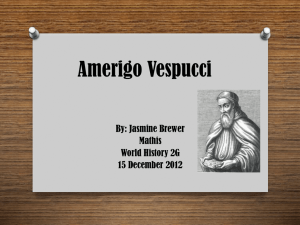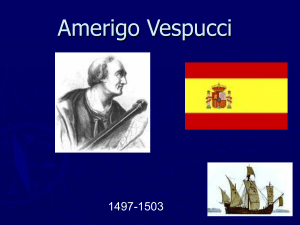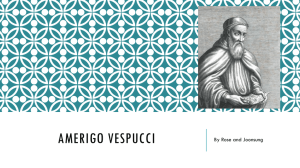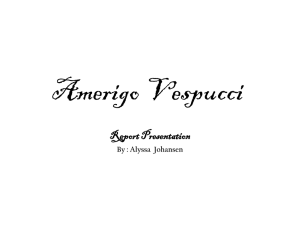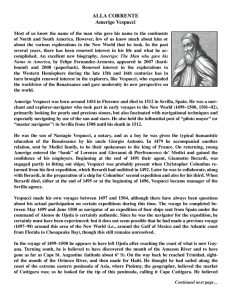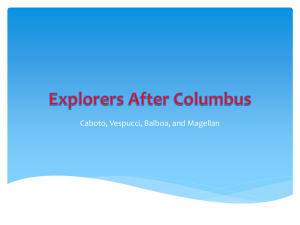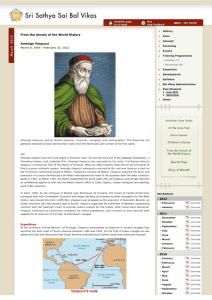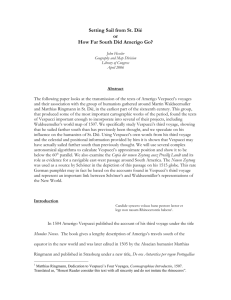The oldest known illustration of South American Indians
advertisement
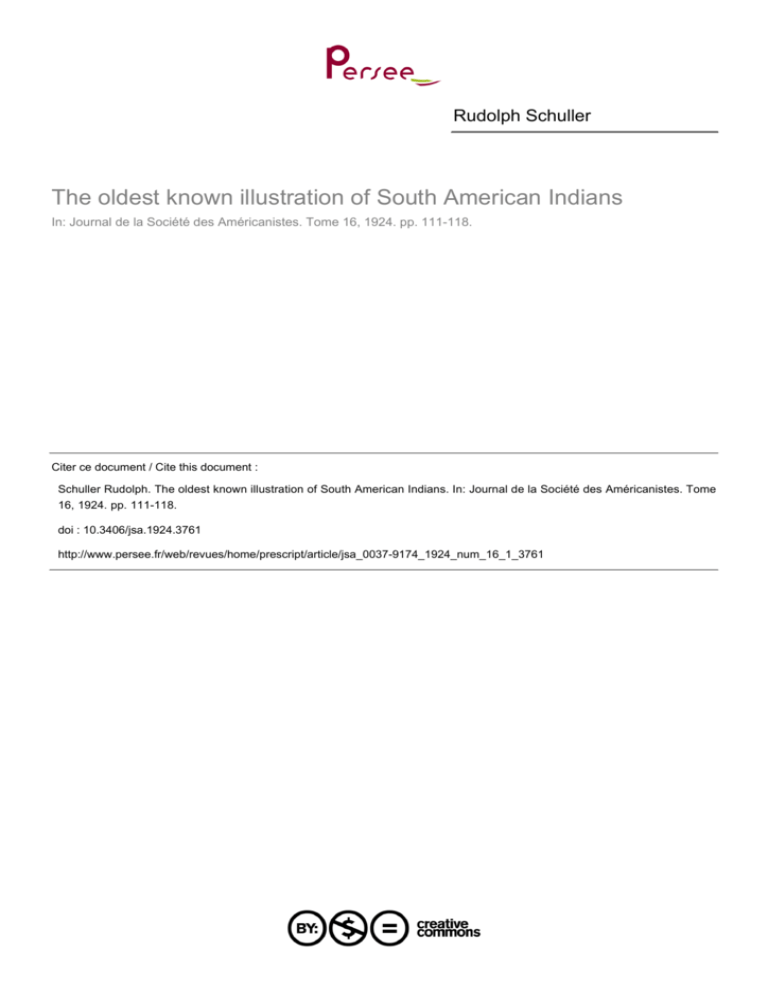
Rudolph Schuller
The oldest known illustration of South American Indians
In: Journal de la Société des Américanistes. Tome 16, 1924. pp. 111-118.
Citer ce document / Cite this document :
Schuller Rudolph. The oldest known illustration of South American Indians. In: Journal de la Société des Américanistes. Tome
16, 1924. pp. 111-118.
doi : 10.3406/jsa.1924.3761
http://www.persee.fr/web/revues/home/prescript/article/jsa_0037-9174_1924_num_16_1_3761
THE OLDEST KNOWN ILLUSTRATION
OF SOUTH AMERICAN INDIANS,
By Prof. Rudolph SCHULLER.
One of the rarest, and, up to the present day, very little known print
concerning South American Indians is an old wood engraving-, eight
and one-half by thirteen and one-half inches, in the library of the British
Museum, at London. This picture represents some of the manners and
costumes of the natives of the eastern coast of Brazil, as first found by
the Portuguese explorers at the beginning of the sixteenth century. The
text in German beneath the picture occupies four lines and is as follows :
« This picture represents to us the people and island which have been
« discovered by the Christian King of Portugal or by his subjects. The
« people are thus naked, handsome, brown, their heads, necks, arms,
« private parts (and the) feet of men and women are a little covered with
« feathers. The men also have дпапу precious stones in their faces and
«breasts. Nor does any one possess any thing, but all things are in
« common. And the men have as wives those who please them, being
« they mothers, sisters, or friends, wherein they make no distinction.
« They also fight with each other and eat each other, even the slain and
« hang the same flesh in the smoke. They become a hundred and fifty
« years old. And have no government » --1.
The first bibliographical description of this' very rare xylographie leaf,
accompanied by a facsimile of the same, as far as I know, was published
by Henry Stevens in the « American Bibliographer », Part I, London,
1854, page 8.
The leaf is without date ; but Stevens believed it was probably printed
at Augsburg or Nurnberg in Bavaria, Germany, between 1497 and 1504.
More or less the same statement we find in Sabin's « Bibliography »,
vol. 1, No. 1, 031, and Vol. V, No. 20, 257.
Stevens' bibliographical notice appears again in his « Historical
1. The translation is almost litterally, in order to preserve the « coloris » of the
German text of the original.
SOCIÉTÉ DES AMÉRICANISTES DES PARIS
112
Nuggets », or « Bibliotheca Americana », vol. I, No. 77, page 20,. where
the leaf is quoted as being printed in 1500.
In exactly the same way it is mentioned by Henry Harrisse in his
excellent work « Bibliotheca Americana Vetustissime », except that this
foremost authority concerning early printed Americana includes the leaf
among the prints of 1497, yet without giving any reason whateverto just
ifythis early date. -.
v""
Finally Justin Winsor in the « Narrative and Critical History of Amer
ica», vol. II, page 19, where is inserted also a reduced facsimile of
the illustration, limits himself to what already had been published by the
former bibliographers on the origin and the date of the print.
Fac-simile of the oldest known wood engraving of South American Indians.
(Bristish Museum, London).
■
■
■
.
The leaf, or broad-leaf, is believed to be unique. The only copy, so far
as now known, was bought at the Puttick 1 and Simpson auction sale in
London by the British Museum for 3£13s6din 1854 (Stevens gives
12 £ .12. s).
■■■■•.."■
In the manuscript notes which I found in Harrisse's own copy of the
«Bibliotheca Americana Vetustissima » in the Library of Congress, at
1. « Botteck » in the manuscript notes of. the copy of Harrisse's « Bibliotheca
Americana Vetustissima », which I consulted in 1915-16, in the Congressional
Library at Washington, D. C, is surely a mistake.
/ .
THE OLDEST KNOWN ILLUSTRATION OF SOUTH AMERICAN INDIANS
113
Washington, however, is mentioned a second copy of the famous print
as belonging1 to the Royal Public Library in Munich, Bavaria. Unfortun
ately, I was not able to verify the assertion of that anonymous colla
tor,owing to the present abnormal conditions of affairs. Be that as it may,
the print, as already stated, bears no date and no name of the author or
the artist. In regard to the date 1497 and 1500, suggested by Stevens
and Harrisse, respectively, I wish to point out that no student well
acquainted with the history of early voyages to America, especially to
South America, can accept either, for this reason. In the first place, the
German text beneath the woodcut states explicitly :
« This picture represents to us the people and island which
■ have been discovered by the'
Christian King of Portugal, or by his subjects. .... »
Thus, the point in question is that of an early expedition to South
America, undertaken by the Portuguese. And there are no positive records
of any expedition ever sent to South America by the Grown of Lusitania
before the years 1500-1501.
■ Now, it is necessary to examine to which one of the early Portuguese
exploring expeditions the anonymous author refers. The first voyage
took place in the spring of 1500. Pedro Alvarez Gabral sailed from Lis
bon direct for the East Indies, March 9, 1500, wTith thirteen vessels, and
discovered^ by a mere accident indeed, on April 22 following, the coast
of Brazil, somewhere in the vicinity of the present Porto Seguro, in the
State of Bahia, where he remained until May 2,1500. He then pursued
his voyage to Calicut, after sending to Portugal Gaspar de Lemos, to
bring the news of the discovery of the land, at that time believed to be
an island, which he named « Terra da Sancta Cruz », the Йо1у Cross
Land. He returned to Lisbon July 29, 1502 !..
Gaspar de Lemos was at the same time bearer of a letter written at
Porto Seguro on May 1,1500, by Pero Vaaz da Caminha, one of the secre
taries of Cabral's fleet, and addressed to the King of Portugal, in which
he gives a detailed account of Cabral's ten days' sojourn on the Brazil
ian
coast and a remarkable description of the Native Indians found in
Porto Seguro.
There is no doubt that Caminha's information was known at the
1. Relazione di Leonardo da. Ca1 Masser alla serenissima republica di Venezia
sopra el commercio dei Portoghesi nelV India dopo la scoperta del Capo di Buona
Speranza »; in « Archivio Storico Italiano ». Tomo II. Appendice. Firenze, 1845,
pp. 51 y 15. Harrisse apparently did not know this account written by Ca' Masser;
cf. The Discovery of North America, London, 1892.
Société des Amérieanisles de Paris. •'■;''
8
114
SOCIÉTÉ DES AMÉRICAN1STES DE PARIS
'
Court of Lisbon so far back as the autumn of 1500. But this highly offi
cial document hardly could have reached the German printers, as it
remained unknown and unpublished until the beginning of the ninteenth
century1.
*•".'■
, It was, therefore, impossible that this German broad-leaf could have
been printed before 1500. But still, even admitting relation between
Gaminha's letter and the German print, the extreme terminus a quo for
the latter, in this case, would be, at least, the last quarter of 1500, or
the beginning of 1501.
Though, a careful comparison of both texts must convince even the
layman that there can be found not the slighest evidence of any kind
of relationship between them, tfyey being, as it can be easily shown,
the work of two entirely different authors.
The question as to how many expeditions were equipped by the Grown
of Portugal at the beginning of the sixteenth century, to prosecute
Cabral's discovery and to explore the Brazilian shores, remains still open.
Most of the writings on the subject are mere conjectures, without any
historic foundation2-.
The fact, proved by documentary evidence, historical as well as car
tographical
3, is that an official Portuguese expedition put out from Lis1. «. Corografia Brazilica ». By Father Manoel Ayres de Cazal. Rio de Janeiro,
Na Impressâo Regia, 1817; 2nd. edit. Rio de Janeiro, 1833. See also « Alguns
Documentes da Torre do Tombo ». Lišboa, 1892. — « Vultos e Descobrimentos ».
Para, 1900.
2. See my «A nova gazeta ta Terra do Brazil [Copia der Newen Zeytung auss
Presillg Landt) » ; in « Annaes da Bibliotheca Nacionál do Rio de Janeiro ».
Vol. XXXIII; 1914.
3. See my paper on the famous Cantino Map « О Mappa Portuguez mais antigo do
Brasil»; in « O Imparcial ». Rio de Janeiro, May 27, 1914.
Cf. likewise Kunstmann II. The entire map, as well as the wonderful planisphere
of the Estensè Library, at Modena, Italy, were reproduced in size of the original in
Dr. Stevenson's « Maps Illustrating Early Discovery and Exploration in America ».
New Brunswick, N. J., 1906, Nos. I and II. The Kunstmann II, an Italian chart, is
probably Vespucci's own work.
Based upon the Cantino map is also the so-called Canerio and the « Kings map »,
the latter published by late Dr. Hamy of Paris.
Surely Vespucci's « Second Voyage ». Dr. J. J. Valentini's attempt to prove that
Vespucci had undertaken a voyage of exploration to America before 1499, can be
considered as a failure. See Valentini's « In the Track of Columbus ». This paper
seems to have appeared in the « Journal of the American Geographical Society ».
There, Valentini tried to connect that highly problematic voyage of the Florentine
merchant with the land (probably mainland of North America-FLORiDA?) which on the
Cantino map appears wrest to the Island of Cuba (La Fernandina).
THE OLDEST KNOWN ILLUSTRATION OF SOUTH AMERICAN INDIANS
115
bon, May 10, 1501 (or May 16), according- to other texts {, a to discover
new land » ; and that those explorers returned to the Texo, September 7,
(or 17), 1502. And the only known account, which comes to us of this
all-important early voyage, is the letter of - Amerigo Vespucci, on his
so-called « Third Voyage » 2, in which is noted the discpvery of Gape of
Sao Augustinho (August 28, 1501), the rivers Sao Miguel (September 29),
Sao Francisco (October 4), the Bahia de Todos os Sanctos (November
First) and the Gabo de Sancta Maria 3 (de la Candelaria, February 2nd,
1502) in the mouth of the Rio de la Plata 4.
We possess numerous editions 5 of this letter printed in Latin, Ita
lian, German and Dutch6, between 1505-1508.
,
1. Up to the present day, nothing we know as to the discoverer of that section of
the shores of North America. It is a highly important and very complicated question
even not explained in a satisfactory way by the foremost authority of early American
Cartography; cf. Harrisse « The Discovery of North America ».
The same may be said ás to the misterious early Portuguese exploration expedition
mentioned in the « Esmeraldo » of John Pacheco. There can be no doubt that is was
an official expedition, which left the harbour of Lisbon shortly after Columbus suc
cessful
trip across the fearful ocean. We do not need to explain here Portugal's
designs. 2. Positively we know only Vespucci's voyage along the northern coast of South
America in 1499-1500, with the famous Spanish Conqueror Alonso de Hojeda. Ves
pucci was then a simple merchant of Seville. The original document referring to
this fact, I have published in « О Марра Portůguez mais antigo do Brasil ». And the
only known document concerning this early exploring expedition on the northern
shores of South America, till the « Cabo de la Vela », more or less, is a Vespucci
letter, too. Though, the itinerary as given by the Florentine does not agree with
that furnished by the anonymous author of a yet unknown manuscript-account on the
same voyage, a very important Spanish document, which I had the chance to disco
verin ajSpanish private archive.
3. Based upon the geographical results of this voyage is the second, later part
of the Cantino Map. See my article on this subject.
4. Wieser, Stevenson, Derby and others give « Sancta Marta », a date which
cannot be conciliated with Vespucci's itinerary. That mistake surely is due to an
erroneous palaeographic interpretation. The old Portuguese and Spanish mariners
used to give to almost every new-found locality the name of the saint on whose feast
day it was discovered. And the day of Sancta Martha is the 27th of July, a date
chronologically impossible, as Vespucci at that time was sailing homeward and had
already passed the Sierra Leona on the coast of Africa.
As to the first discovery of the mouth of the River Plate, see my already quoted
article on the « Newe Zeytung auss Presillg Landt » ; and cf. also the Cantino map.
5. Harrisse, « Vetustissima »; and the « Additions » of the same author. Fumagalli (Uzielli) : « Vita d i Amerigo Vespucci scritta da Angelo Maria Bandini con le
postille inédite delV autore illustrata e commenlata da Gustavo Uzielli. Bibliografia delle
opere concernenti Paolo Toscanelli ed Amerigo Vespucci per Giuseppe Fumagalli. »
In Firenze Auspice in Comune April MDCCCIIC (1898), in-folio.
■
6. The unique known copy printed at Antwerp, 1506-1508 (1510?), is in the posses-
116
SOCIÉTÉ DES AMÉRICANISTES DE PARIS
.
.
The best known is that included in the collection of travels and disco
veries « Paesi nuouamente retrouati. Et nouo mondo da Alberigo Vesputio Florentino intitulato » (Newly Discovered Lands; etc.), published bj
Fracanzano da Montalboddo in Vicenza, Italy, 1507. In this letter, which
was written probably early in 1303, and which is addressed to Lorenzo
Pietro de' Medici of Florence, referring to the native Indians Vespucci
met somewhere on the Brazilian coast, we are told that those Indians
« None have patrimony among1 them, but every thing is common. They
have neither King (chief) nor government ; and each one is his own mast
er. They take as many wives as they please. In the intercourse of the
sexes they have no regard to kindred, intermarrying the son with the
mother, the brother with the sister (and so on),.. ...in these things
they live ungoverned by reason
».
« Their cheeks, their jaws, their noses, lips and ears have not one
little hole only, but many large ones in them ; so that I have often seen
one with seven holes in the face ».
« ..... it will hardly be believed, that one man had seven stones in
his face, each one more than a half a span in size. . . . . »
«
I saw in the houses of a certain Indian village, in which I
remained twenty-seven days, where human flesh, having been salted (?),
was suspended from the beams of the dwellings, as we use to do with
bacon and pork..... »
■
_ Then he observes » ..... they live a hundred and fifty years ».
In the letter of Vespucci as published by Count Baldelli *, and repro
duced by Varnhagen 2, there we read :
« ... they have no laws, and no religious belief, but live according to
the dictates of nature... they have no private property, but every thing
is common ; they have no king, they do not obey any body, being each
one his own master. ....»■
« The men are in the habit of piercing their lips and cheeks and in
these holes they introduce then bones and stones; and do not believe
(that they are) little ones
. »
•
«... the meat they eat, specially the usual, is human ffesh
»
«
this is certain ; for we found human flesh in their huts hung up
to smoke
»
sion of the rich americanistic library, surely unique sui generis, of Mr. John Carter
Brown, in Providence, R. I., United States of North America. Only twenty-five fac
simile
copies were printed, 1874, for private distribution.
1. Conte J3aldelli Boni, « II Milione di Marco Polo •>. Firenze, Pagani, 1827. Vol. I.
2. a Amerigo Vespucci ». Son caractère, ses écrits (même les moins authentiques),
etc., par Francisco Adolpho de Varnhagen. Lima, 1865.
THE OLDEST KNOWN ILLUSTRATION OF SOUTH AMERICAN INDIANS
117
.
.
.
.
.
"
•
.
.
.
And in another place, he says : « ..... they fight each other and they
kill each other..... they are a people wich lives many years.....
'(132 years!!!).
.
.: /\
У
'.
;".
:
Here isone thing particulary worthy of mention, Lionardo Giovanni da
Empoli, of a Tuscan marchant and banker family *, in a letter written at
Lisbon, September 16, 1504, and addressed to his father in Italy, giving
him account of the voyage to the East Indies, he had then accomplished,
with the great Portuguese conquerer Aft'onso da /Albuquerque, among
other things, refers : «'
. we arrived at the Holy Cross Land, time ago
discovered by Amerigo Vespucci.
». And speaking of the Indians of
Brazil, named by him also « The True Cross-Land » 2, he says « . . . the
people there (in Brazil) is well formed, they go naked
they adorn
themselves with parrots' feathers
and their lips full offish-bones
.
they have no faith, but live as epicureans. .... they eat usually their
war prisoners,- human flesh, which they dry in the smoke as we do hog's
flesh ».
As it would involve a long dissertation about the authority of those
passages in Giovanni da Empoli's letter, I pass over, whether it is his
own observation, or whether it is merely an extract from á Vespucci let
ter. If so, it is most remarkable in a letter written at the close of 1504;
and, surely, deserves the attention of all students of Vespucci literarature 3.
Finally, the words : «_the people and island which have been discove
red
by the Christian King of Portugal. .... » do not occur in any of the
numerous Latin and Italian editions of the Vespucci letter, but only in
the title of those printed in Germany, as for instance, in the Nurnberg
and in the Leipzig edition of 1505 ; and in the Strassburg edition of
1506, whose title commences, as follows :
• « Von den newen Insulen und Landern kiirzlich durch den christenlichen Kunig von Portugal wol erfunden sind » (Concerning the now
islands and countries which have lately been discovered by the Christian
King of Portugal) . And beneath the « Colophon » of the Strassburg
1. Chopia de una lectera mandata da Giovanni da Empoli a Lionardó suo padre
del viaggio /e' « a Malacha », published by Giuglielmo Berchet in « Narrazioni Sincrone-Raccolta Colombiana-Fonti Italiane ». Parte III, vol. II. Roma, MDGCCXCII,
No. LXXXII, pp. 180,181. See also « Viaggio fatto nell" India per Giovanni da Empoli
fattore su la nave del seren. re di Portogallo,per conlo di Marchionni de Lisbona (with
some variation); in Ramvsio « Navigat. et Viaggi ». Tomo I, Venezia, 1554.
2. Name employedalso by Mestre Joao Physico and by the anonymous Portuguese
author of ,the Cantino planisphere.
3. On this subject, see also Ilumboldt « Examen Critique », vol. V, p. 139.
SOCIÉTÉ DES AMÉRICANISTES DE PARIS
118
ч
edition ^there we find even a woodcut of the King of Portugal receiving
Vespucci 2.
Whatever I may have omitted, I think, after such conclusive proofs,
there can be no further doubt as to the origin of the description of the
Indians presented in this illustration. And, as the German translations
of the Vespucci-letter were all made from a copy which some booksell
ers
beyond the Rhine must have obtained from Paris as early as May,
1505, it is logic that this broad-leaf must have been printed after that
date; perhaps in 'the same office and at the same time as the famous
« New Gazette from the Brazil-Land 3, another German broad-leaf, which,
as I have already shown in a pamphlet '♦ presented to the Nineteenth
International Congress of Americanists, in Washington, D. C, is also
based upon Vespucci's narrative of his first voyage to Brazil by order of
King Dom Manoel л о Grande » of Portugal.
The question as to whether the illustration is a deriváte of some yet
unknown original prototype, or whether it is a drawing based upon Ves
pucci's
description and made by some German artist, I must, of course,
leave unanswered. The Indians represented there, undoubtedly, belong
to the Tupí of the eastern coast of Brazil. Vespucci never met there вотоcudo-crên-cran (Tapuya-Ges) 5, as has incorrectly been asserted again
and again by some students.
Mexico City, November, 1923.
'
.
.
.
■
'
1. See « Vetustissima », No. 40, No, 41, Leypzick, 1506 ; and « Additions », No. 20
and 21, sine loco, printed 1505.
2. Published in facsimile at Paris.
3. Annaesda Bibliotheca Nacionál do Rio de Janeiro. Vol. XXXIII, Rio de Janeiro,
1914.
.
.
4. On Prof. Oberhummer's observations as to my thesis I shall revert on another
place.
5. « Die atteste ethnographische{!) Skizze iiber die Botokuden indeutscher Sprache ».
By Schulze (Franz Briefnitz) ; in «■ Globus ». LXXX. Braunschweig, 1900, pp. 242243.
,
Absolute ignorance as to the material culture of both the Tupi-Guarani and Botocudo-Crên-Crân. This is the only conclusion to be drawn from Schulze's article.
